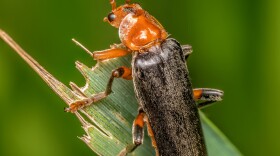Some insects have naturally evolved to perfectly blend into their environment. Many species have adopted a body shape and coloration that makes them look like bark, a leaf, or a flower, a perfect way to hide from predators in plain sight. Other insects don’t need to blend in. They’ve evolved effective defenses to avoid becoming a meal for something else, like the sting of a bee or wasp. This defense is so effective as a deterrent to being eaten that other species of otherwise harmless insects have evolved to look like species that CAN deliver a painful sting, adopting an appearance that makes potential predators think twice. However, many species are just not that lucky. Their evolutionary path did little in regard to providing camouflage or the ability to deter potential predators. To stay safe, some of them need to work a little harder. The Wavy-lined Emerald Moth is a beautiful lime-green colored moth found in just about every state in the lower 48 states. Another common name for this beautiful moth is the Camouflaged Looper, a name most fitting for its amazing caterpillars. Without coloration or a body shape that helps them blend into their environment, these caterpillars have developed an ingenious way to try and disappear. They decorate themselves with carefully cut pieces of the plant (typically the flowers) they are living on. Not only does this home-made cloak shield them visually from hungry eyes, it provides a barrier to being detected from the chemical sensors that predators (like spiders) have on their legs. Once the plant material making up their coat begins to wilt or brown in color, they simply discard it and begin making a new one
Camouflaged Looper

Pavel Abramov/Getty Images




